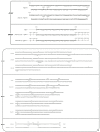Human Polyomaviruses in the Cerebrospinal Fluid of Neurological Patients
- PMID: 31861837
- PMCID: PMC7022863
- DOI: 10.3390/microorganisms8010016
Human Polyomaviruses in the Cerebrospinal Fluid of Neurological Patients
Abstract
Background: Central nervous system (CNS) infections by human polyomaviruses (HPyVs), with the exception of JC (JCPyV), have been poorly studied.
Methods: In total, 234 cerebrospinal fluid (CSF) samples were collected from patients affected with neurological disorders. DNA was isolated and subjected to quantitative real-time PCR (Q-PCR) for the detection of six HPyVs: JCPyV, BKPyV, Merkel cell PyV (MCPyV), HPyV6, HPyV7, and HPyV9. Where possible, the molecular characterization of the viral strains was carried out by nested PCR and automated sequencing.
Results: JCPyV was detected in 3/234 (1.3%), BKPyV in 15/234 (6.4%), MCPyV in 22/234 (9.4%), and HPyV6 in 1/234 (0.4%) CSF samples. JCPyV was detected at the highest (p < 0.05) mean load (3.7 × 107 copies/mL), followed by BKPyV (1.9 × 106 copies/mL), MCPyV (1.9 × 105 copies/mL), and HPyV6 (3.3 × 104 copies/mL). The noncoding control regions (NCCRs) of the sequenced viral strains were rearranged.
Conclusions: HPyVs other than JCPyV were found in the CSF of patients affected with different neurological diseases, probably as bystanders, rather than etiological agents of the disease. However, the fact that they can be latent in the CNS should be considered, especially in immunosuppressed patients.
Keywords: cerebrospinal fluid; human polyomaviruses; neurological diseases.
Conflict of interest statement
The authors declare no conflict of interest.
Figures


Similar articles
-
Genetic Diversity of the Noncoding Control Region of the Novel Human Polyomaviruses.Viruses. 2020 Dec 7;12(12):1406. doi: 10.3390/v12121406. Viruses. 2020. PMID: 33297530 Free PMC article. Review.
-
Detection Analysis and Study of Genomic Region Variability of JCPyV, BKPyV, MCPyV, HPyV6, HPyV7 and QPyV in the Urine and Plasma of HIV-1-Infected Patients.Viruses. 2022 Nov 17;14(11):2544. doi: 10.3390/v14112544. Viruses. 2022. PMID: 36423152 Free PMC article.
-
Studies of human polyomaviruses, with HPyV7, BKPyV, and JCPyV present in urine of allogeneic hematopoietic stem cell transplanted patients with or without hemorrhagic cystitis.Transpl Infect Dis. 2016 Apr;18(2):240-6. doi: 10.1111/tid.12500. Transpl Infect Dis. 2016. PMID: 26809742
-
Natural History of Cutaneous Human Polyomavirus Infection in Healthy Individuals.Front Microbiol. 2021 Oct 18;12:740947. doi: 10.3389/fmicb.2021.740947. eCollection 2021. Front Microbiol. 2021. PMID: 34733257 Free PMC article.
-
[New, newer, newest human polyomaviruses: how far?].Mikrobiyol Bul. 2013 Apr;47(2):362-81. doi: 10.5578/mb.5377. Mikrobiyol Bul. 2013. PMID: 23621738 Review. Turkish.
Cited by
-
Polyomavirus Wakes Up and Chooses Neurovirulence.Viruses. 2023 Oct 18;15(10):2112. doi: 10.3390/v15102112. Viruses. 2023. PMID: 37896889 Free PMC article. Review.
-
HPyV6 and HPyV7 in urine from immunocompromised patients.Virol J. 2021 Jan 22;18(1):24. doi: 10.1186/s12985-021-01496-1. Virol J. 2021. PMID: 33482864 Free PMC article.
-
Genetic Diversity of the Noncoding Control Region of the Novel Human Polyomaviruses.Viruses. 2020 Dec 7;12(12):1406. doi: 10.3390/v12121406. Viruses. 2020. PMID: 33297530 Free PMC article. Review.
-
Cerebrospinal fluid in COVID-19: A systematic review of the literature.J Neurol Sci. 2021 Feb 15;421:117316. doi: 10.1016/j.jns.2021.117316. Epub 2021 Jan 10. J Neurol Sci. 2021. PMID: 33561753 Free PMC article.
-
Emerging role of human polyomaviruses 6 and 7 in human cancers.Infect Agent Cancer. 2021 May 17;16(1):35. doi: 10.1186/s13027-021-00374-3. Infect Agent Cancer. 2021. PMID: 34001216 Free PMC article. Review.

